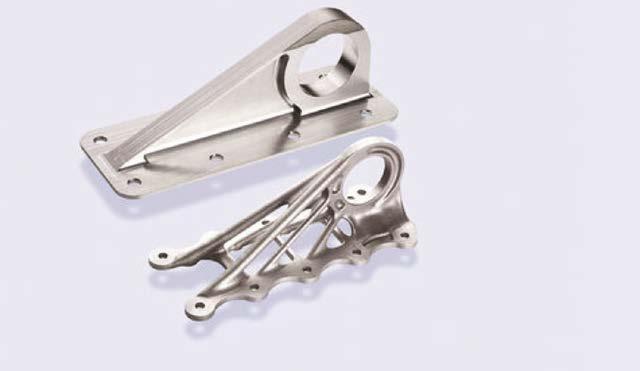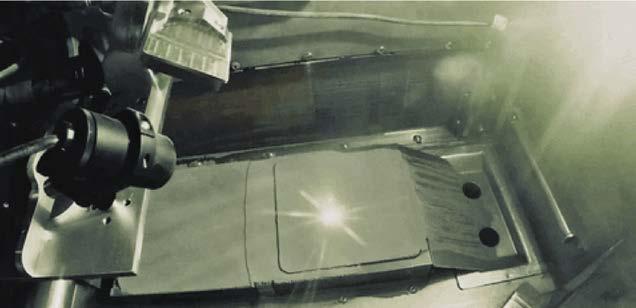
3 minute read
THE DEVELOPMENT OF ALUMINIUM ADDITIVE MANUFACTURING
Dr Julan Wu, University of Birmingham
The use of aluminium has been increasing in recent years due to its many benefits, including the benefits of its strength, durability, lightweight properties, corrosion resistance, and heat resistance. Additionally, aluminium is a good conductor of electricity and heat, making it a popular choice for many industrial and commercial applications. Additive manufacturing methods, also known as aluminium 3D printing, are attracting interest from both research and industry for the capabilities to produce complex geometric structure which are unattainable using other techniques. Using AM, a part is produced layer-by-layer guided by the three-dimensional models. There are many benefits to produce aluminium using AM, including: reduced waste, increased geometry design freedom, efficiency, flexibility etc. It is potential to minimise the waste by shape optimisation and post machining and shorten the design-to-manufacture time by reducing the manufacturing steps by a single step. Many stakeholders in the industry have focused on Additive manufacturing (AM) aluminium, including suppliers of aluminium goods and powders, Additive manufacturing (AM) technology developers, and AM service providers. In the last few years, aluminium AM has grown exponentially, becoming one of the most widely demanded materials in the industry after being one of the more difficult metals to process.
Aluminium AM involves using a 3D printer to create objects out of aluminium powder or aluminium-filled thermoplastics. With the technology advancing in recent years, the usage of aluminium AM is increasing and expected to become more popular in the coming years. AM aluminium parts have now been used in aerospace and automotive products where parts with complex geometries, lightweight and high strength are expected. AM has the potential to revolutionize the way aluminium products are designed and manufactured. However, there are several challenges that need to be addressed before it can become a mainstream production method for aluminium.
One of the main challenges is achieving the same level of mechanical properties in AM aluminium parts as in conventionally manufactured parts. This is because the microstructure of AM parts is typically different than that of conventionally manufactured parts and the formation of defects, which can affect their strength and toughness. Another challenge is the high cost of AM equipment and materials, which can make the process less cost-effective than traditional manufacturing methods for some applications. In recent years, with the development of technology and the reduction of cost, more and more industries are starting to adopt AM aluminium, especially in aerospace, automotive and medical industries.
A trend in additive manufacturing aluminium is the use of Laser Powder bed fusion (PBF-LB) process, which is one of the most common AM processes for metals, it uses a laser to melt metal powder and build up the parts layer by layer. In general, PBF-LB of aluminium provides the strengths of higher geometric design freedom and enhanced microstructure. During the PBF-LB process, metal powder is melted by the high energy density laser beam and solidify rapidly to room temperature. The rapid cooling rate form the ultrafine microstructure within the melt
• Production process of laser powder bed fusion of additive manufacturing.
(Source: Sandia National Labs)
• Example of a part of an aircraft: An AM part with optimum design structure offering lightweight (bottom) compared to a conventional part (top).

(Source: Airbus)
• The first 3D-printed motorcycle from aluminium by Airbus.

(Source: Airbus) pool. Chemical modifiers are required in traditional cast alloys to enhance the microstructure and improve the mechanical properties. Another advantage for PBF-LB to produce aluminium is the microstructural enhancement by refining the microstructure from rapid solidification during the production without altering the chemical composition. The refined microstructure improves the properties of tensile and compressive strength, hardness, fatigue, creep, and wear resistance and electrical properties. Although ductility of AM aluminium is lower, proper heat-treatment provides enhancement on the ductility while not impact the strength significantly. PBF-LB also offers the advantage of producing Al-alloys which are challenging to machine or form.
PBF-LB of high strength aluminium alloys presents a challenge due to the formation of cracks during the final stages of solidification. These cracks occur as a result of material shrinkage. To overcome this issue, researchers are exploring the use of in-situ alloying to develop new alloy, which involves adding elements to the alloy composition to promote heterogeneous nucleation during solidification. This changes the microstructure from a columnar structure, which is common in SLM materials, to an equiaxed microstructure, effectively eliminating the formation of cracks.
For further information please contact Jas Bahra, Business Engagement Manager, University of Birmingham. Email: j.bahra@bham.ac.uk - Phone: 074545 21030.









